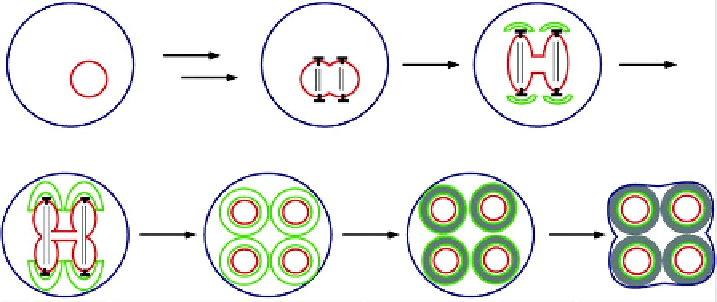Biology Reference
In-Depth Information
(A)
(B)
(C)
Prospore
membrane
formation
Membrane
expansion
Meiosis I
Start
meiosis II
(E)
(F)
(G)
(D)
Membrane
closure/
nuclear
capture
Spore wall
assembly
Ascal
maturation
Figure 2.20
(A-G) Overview of the stages of spore and ascus formation. In the presence
of a nonfermentable carbon source, diploid cells starved for nitrogen will undergo meiosis.
During the second meiotic division, the spindle polar bodies (SPBs, indicated as ┬), which
are embedded in the nuclear envelope (shown in red), become sites for formation of prospore
membranes (shown in green). As meiosis II proceeds, the prospore membranes expand and
engulf the forming haploid nuclei. After nuclear division, each prospore membrane closes on
itself to capture a haploid nucleus within two distinct membranes. Spore wall synthesis then
begins in the lumen between the two prospore membrane-derived membranes. After spore
wall synthesis is complete, the mother cell collapses to form the ascus (
Neiman, 2005
).
Reproduction Through Sporulation
Sporulation (yeast gametogenesis) is the main reproduction mode for most fungi.
Formation of spores may occur asexually or sexually by the union of male and
female gametes. It is in many respects similar to gametogenesis in mammalian cells
(
Figure 2.20
).
Sexual Reproduction in Yeasts
Sexual reproduction is less widespread in yeasts than asexual reproduction by bud-
ding. It is prevalent during unfavorable environmental conditions. Under stressful
conditions, diploid yeast cells reproduce via sporulation (sexual reproduction), form-
ing haploid spores of type
a
and
α
, which again can conjugate to produce diploid
cells, and so on (
Figure 2.21
).
Sexual Reproduction in Green Algae (
Chlorophyta
)
Green algae is a group of about 7,000 unicellular photosynthetic eukaryote species.
Most of them are free-living unicellular organisms, but others form colonies, such as

Search WWH ::

Custom Search